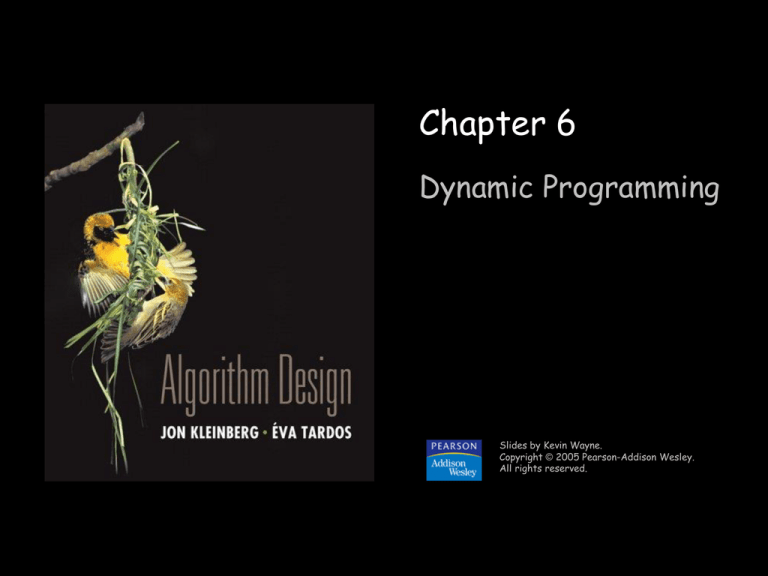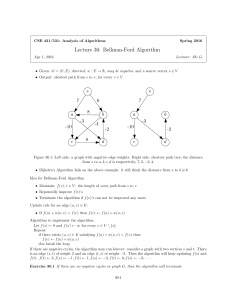
Chapter 6
Dynamic Programming
Slides by Kevin Wayne.
Copyright © 2005 Pearson-Addison Wesley.
All rights reserved.
1
6.8 Shortest Paths
Shortest Paths
Shortest path problem. Given a directed graph G = (V, E), with edge
weights cvw, find shortest path from node s to node t.
allow negative weights
Ex. Nodes represent agents in a financial setting and cvw is cost of
transaction in which we buy from agent v and sell immediately to w.
s
10
2
9
18
6
6
30
15
-8
5
16
44
6
-16
11
20
7
3
19
4
6
t
3
Shortest Paths: Failed Attempts
Dijkstra. Can fail if negative edge costs.
2
u
3
s
v
1
-6
t
Re-weighting. Adding a constant to every edge weight can fail.
5
2
s
6
3
5
2
0
-3
6
3
t
4
Shortest Paths: Negative Cost Cycles
Negative cost cycle.
-6
-4
7
Observation. If some path from s to t contains a negative cost cycle,
there does not exist a shortest s-t path; otherwise, there exists one
that is simple.
s
W
t
c(W) < 0
5
Shortest Paths: Dynamic Programming
Def. OPT(i, v) = length of shortest v-t path P using at most i edges.
Case 1: P uses at most i-1 edges.
– OPT(i, v) = OPT(i-1, v)
Case 2: P uses exactly i edges.
– if (v, w) is first edge, then OPT uses (v, w), and then selects best
w-t path using at most i-1 edges
0
OPT(i, v)
min
OPT(i 1, v) ,
if i 0
OPT(i
1,
w)
c
min
vw otherwise
(v, w) E
Remark. By previous observation, if no negative cycles, then
OPT(n-1, v) = length of shortest v-t path.
6
Shortest Paths: Implementation
Shortest-Path(G, t) {
foreach node v V
M[0, v]
M[0, t] 0
}
for i = 1 to n-1
foreach node v V
M[i, v] M[i-1, v]
foreach edge (v, w) E
M[i, v] min { M[i, v], M[i-1, w] + cvw }
Analysis. (mn) time, (n2) space.
Finding the shortest paths. Maintain a "successor" for each table
entry.
7
Shortest Paths: Practical Improvements
Practical improvements.
Maintain only one array M[v] = shortest v-t path that we have
found so far.
No need to check edges of the form (v, w) unless M[w] changed
in previous iteration.
Theorem. Throughout the algorithm, M[v] is length of some v-t path,
and after i rounds of updates, the value M[v] is no larger than the length
of shortest v-t path using i edges.
Overall impact.
Memory: O(m + n).
Running time: O(mn) worst case, but substantially faster in practice.
8
Bellman-Ford: Efficient Implementation
Push-Based-Shortest-Path(G, s, t) {
foreach node v V {
M[v]
successor[v]
}
M[t] = 0
for i = 1 to n-1 {
foreach node w V {
if (M[w] has been updated in previous iteration) {
foreach node v such that (v, w) E {
if (M[v] > M[w] + cvw) {
M[v] M[w] + cvw
successor[v] w
}
}
}
If no M[w] value changed in iteration i, stop.
}
}
9
6.9 Distance Vector Protocol
Distance Vector Protocol
Communication network.
Nodes routers.
Edges direct communication link.
naturally nonnegative, but Bellman-Ford used anyway!
Cost of edge delay on link.
Dijkstra's algorithm. Requires global information of network.
Bellman-Ford. Uses only local knowledge of neighboring nodes.
Synchronization. We don't expect routers to run in lockstep. The
order in which each foreach loop executes in not important. Moreover,
algorithm still converges even if updates are asynchronous.
11
Distance Vector Protocol
Distance vector protocol.
Each router maintains a vector of shortest path lengths to every
other node (distances) and the first hop on each path (directions).
Algorithm: each router performs n separate computations, one for
each potential destination node.
"Routing by rumor."
Ex. RIP, Xerox XNS RIP, Novell's IPX RIP, Cisco's IGRP, DEC's DNA
Phase IV, AppleTalk's RTMP.
Caveat. Edge costs may change during algorithm (or fail completely).
1
s
2
1
v
1
t
"counting to infinity"
1
deleted
12
Path Vector Protocols
Link state routing.
not just the distance and first hop
Each router also stores the entire path.
Based on Dijkstra's algorithm.
Avoids "counting-to-infinity" problem and related difficulties.
Requires significantly more storage.
Ex. Border Gateway Protocol (BGP), Open Shortest Path First (OSPF).
13
6.10 Negative Cycles in a Graph
Detecting Negative Cycles
Lemma. If OPT(n,v) = OPT(n-1,v) for all v, then no negative cycles.
Pf. Bellman-Ford algorithm.
Lemma. If OPT(n,v) < OPT(n-1,v) for some node v, then (any) shortest
path from v to t contains a cycle W. Moreover W has negative cost.
Pf. (by contradiction)
Since OPT(n,v) < OPT(n-1,v), we know P has exactly n edges.
By pigeonhole principle, P must contain a directed cycle W.
Deleting W yields a v-t path with < n edges W has negative cost.
v
t
W
c(W) < 0
15
Detecting Negative Cycles
Theorem. Can detect negative cost cycle in O(mn) time.
Add new node t and connect all nodes to t with 0-cost edge.
Check if OPT(n, v) = OPT(n-1, v) for all nodes v.
– if yes, then no negative cycles
– if no, then extract cycle from shortest path from v to t
t
0
0
0
0
0
18
2
5
6
-23
-15
v
-11
16
Detecting Negative Cycles: Application
Currency conversion. Given n currencies and exchange rates between
pairs of currencies, is there an arbitrage opportunity?
Remark. Fastest algorithm very valuable!
8
$
F
1/7
800
4/3
2/3
3/10
2
3/50
IBM
1/10000
£
170
DM
56
¥
17
Detecting Negative Cycles: Summary
Bellman-Ford. O(mn) time, O(m + n) space.
Run Bellman-Ford for n iterations (instead of n-1).
Upon termination, Bellman-Ford successor variables trace a negative
cycle if one exists.
See p. 288 for improved version and early termination rule.
18






